Is There A Way To Use The Screen On The Camera To See The Picture On A Nikon D3000
Nikon D3000 -
- Written past
Nikon D3000 design and controls
The D3000 is Nikon's latest entry-level DSLR, replacing the earlier D60. Externally, it's almost identical to the D60 and D40x earlier that. Like those models it's a relatively small and light DSLR, with a plastic beat and simple controls aimed at beginners. We've pictured it below alongside its two biggest rivals in the budget DSLR market: Canon'south EOS 1000D / Insubordinate XS and Sony's Alpha DSLR-A230.
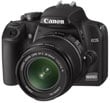 | ||
 |
Measuring 126x97x64mm, the D3000 is the aforementioned width and depth as the D60, but 3mm taller. Nikon has however shaved 10g from the total weight, with the D3000 weighing 536g when fitted with its rechargeable battery or 801g when the DX 18-55mm VR kit lens besides mounted. Catechism's EOS 1000D / XS is almost the same size at 126x98x62mm, while Sony's Alpha A230 is a tad bigger at 128x97x68mm. Both rivals come up slightly lighter in their body plus battery configurations at 500g each.
While the dimensions and construction may be like though, the look and feel of the three rivals are quite different. This is very much a personal choice, but in our hands, the Nikon D3000 felt best of all 3 with Nikon'due south trademark hooked inner area in the grip giving the impression of greater security.
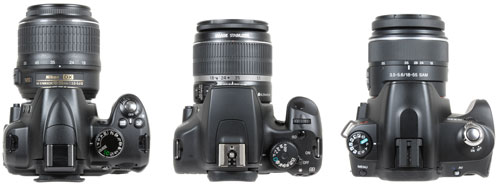 |
Don't go us wrong though, the D3000'southward grip doesn't feel anywhere nigh as good as those on Nikon's higher-stop DSLRs, like the D90, but ergonomically it remains a footstep-upwardly from virtually budget models. Catechism's EOS 1000D / XS came a close 2d, with both models feeling much better in our hands than Sony's Alpha A230 with its unusual pointed grip which nosotros merely didn't get on with. One time again this is a personal choice and we'd recommend anyone who'south undecided nigh all iii should pick them up in person.
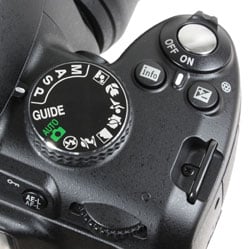 |
In terms of controls, the D3000 is almost identical to its predecessor with only pocket-sized changes. The upper correct side is home to the main command dial which offers Auto, Program, Manual, Aperture and Shutter Priority modes along with vii scene presets. New to the D3000's way dial though is a GUIDE option which as its proper noun suggests, provides goal-oriented guidance for beginners. This is ane of the major differences between the D3000 and its predecessor – not to mention its rivals – and we'll be discussing it in greater particular lower down this folio.
The rotary on / off switch is positioned effectually the shutter release, with 2 buttons alongside. I adjusts the exposure bounty, while the other toggles the screen information on and off. Interestingly this 'Info' push was dedicated to adjusting the Agile D-Lighting options on the D60, as it employed sensors below the viewfinder to automatically switch the screen on and off. Cheers to its larger screen though, the D3000 has sacrificed these sensors, so it's back to the aforementioned system as the earlier D40x where the screen has to be manually switched on and off (at least until power-saving switches information technology off for you).
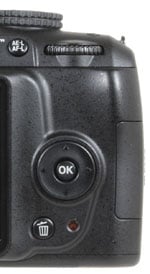 |
The rear surface features a similar number of buttons to its rivals, but there's far less labelling – indeed similar the D60, the traditional iv-fashion rocker to the right of the screen is bereft of any labelling what-so-ever. At first this may seem a strange omission, simply it's all part of Nikon'due south strategy to make the D3000 as approachable and unintimidating as possible. It's also because unlike rival models, these rocker controls do not have a dual purpose, and are only used for basic menu navigation.
A thumb dial in the upper right corner of the D3000's rear allows yous to brand exposure adjustments or scroll through images in playback, while a button labelled with a question mark in the lower left corner presents context-sensitive assistance on the screen. A push button below it labelled with a letter 'i' is used to admission a number of settings including White Balance, ISO, focusing, metering and quality modes from the default data screen.
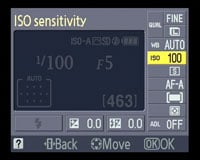 |
To adjust any of these y'all'll start need to press the 'i' button with the screen already on, which switches the D3000 to its 'Quick Settings' mode. This presents a number of settings along the right and bottom sides of the screen in a backwards 'Fifty' shape with one highlighted in xanthous. Next you use the 4-manner rocker to highlight the desired setting earlier pressing OK to finally access the bachelor options.
While we empathise Nikon's designed this system for first-fourth dimension DSLR owners, it can go infuriatingly slow in exercise for anyone who'southward familiar with the organisation. Depending on which function was highlighted terminal, you could find yourself having to press the rocker control many times to navigate to another setting simply to make a unproblematic adjustment. Nikon really should have offered direct access to the nigh common settings like ISO and White Balance by doubling-upwards the functions of either the 4-way rocker like well-nigh every other photographic camera. Canon and Sony both offering straight access to these settings, and it's abrasive not to detect them hither.
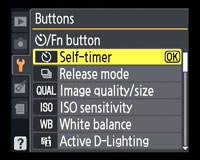 |
On the upside the D3000, like its predecessor, shows handy thumbnail examples of how each setting may exist used in do, several of which we'll show below and on the next page. And offer some relief is a programmable office button on the body's left side, which past default sets the self-timer, but tin can be fix to alternatively offer straight access to the release mode, quality, ISO, white balance, or Active D-Lighting settings.
Note in that location's still no optical depth-of-field preview on the D3000, although Sony'southward Blastoff A230 doesn't have one either. Canon is standing relatively solitary in the budget category by offer ane on its EOS 1000D / XS.
Nikon D3000 flash
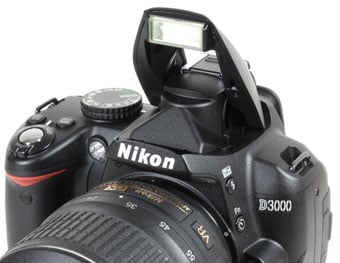 |
|
The Nikon D3000 is equipped with both a popup flash with a Guide number of 12 and a hotshoe for external flashguns.
Flash compensation and ability level is adaptable, and you can also cull from red-eye, slow-sync and rear-curtain options.
The built-in flash Guide number increases to xiii with transmission control, which matches that of the Catechism EOS 1000D / XS; both beat the relatively weak popup flash on the Sony A230 which has a Guide number of 10.
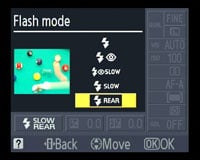 |
The D3000's congenital-in wink can either popup automatically or by pressing a push on the side of the D3000, and once yous're finished with it, just push it back into place.
Like the D60, the D3000'south maximum flash sync speed is an average one/200, leaving us to fondly reminisce about the discontinued D40 which inherited the surprisingly quick i/500 flash sync speed of the much older D50; ironic since both were entry-level models.
If you mount a compatible flashgun like the SB-400, SB-600, SB-800 or SB-900, the D3000 tin support the Nikon Creative Lighting System (CLS) which offers iTTL control.
Nikon D3000 Viewfinder
The Nikon D3000 employs a penta-mirror optical viewfinder system which delivers 95% coverage and 0.8x magnification. This is the same specification equally its predecessor, although there'south two fundamental differences we'll mention in a moment.
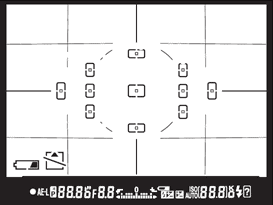 | |
Technically speaking, the apparent size of the D3000's viewfinder falls between that of the Sony A230 and Catechism EOS 1000 / XS, existence fractionally smaller than the former and fractionally larger than the latter. Only await through all iii ane later on each other and you're unlikely to find whatever difference – in terms of coverage and apparent size anyway.
What you lot will notice though is the number of AF markings: the earlier D60 was equipped with a very bones three-bespeak AF system which over fourth dimension had been over-taken past the vii-signal and ix-point systems of the Canon 100D / XS and Sony A230 respectively. Now the D3000 leapfrogs both rivals by inheriting the 11-point AF system of the higher-end D90 and D5000 models. This is a pregnant upgrade which nosotros'll describe in detail on the Features page.
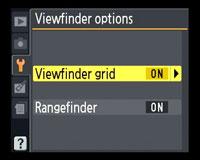 |
Nosotros're pleased to report the D3000 has also inherited the on-need LCD alignment filigree of the D90 and D5000. This is a wonderful facility where helpful guidelines can exist switched on or off as desired in the viewfinder, and a central reward it has over rival models; indeed Canon has only just started offering something similar on its loftier-end EOS 7D. To be fair though it is worth noting the Canon EOS 1000D / XS offers a grid option during Live View.
Sadly the D3000's improved viewfinder still doesn't show the ISO value at all times. In this respect it's no different from Sony's A230, although to its credit, Canon shows the information at all times on the EOS 1000D / XS.
Additionally, the 2d difference between the D3000's viewfinder and its predecessor isn't such a happy one: the eye sensors below the D60'southward viewfinder have been sacrificed here to make room for the bigger screen. This means the screen won't switch off automatically when you bring your middle to the viewfinder, and y'all'll instead have to either manually switch information technology off with a button-press, or expect for the ability-saving to boot-in. To exist off-white, Canon'south EOS 1000D / XS doesn't have eye sensors either, although Sony's Alpha A230 does.
Nikon D3000 screen and menus
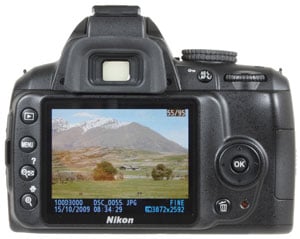 |
The Nikon D3000 is equipped with a 3in / 230k screen – that's one-half an inch bigger than its predecessor, although the aforementioned resolution. This bigger screen is the about obvious external departure between the D3000 and the D60, and as well makes it the biggest in the upkeep DSLR category, compared to the 2.7in screen of the Sony A230 and the ii.5in screen on the Canon EOS 1000D / XS.
A bigger screen is certainly a nice affair to take on a digital photographic camera, although in the case of the D3000, it's meant sacrificing the viewfinder eye-sensors of the before D60. More importantly, similar its predecessor, the D3000 cannot use its screen for limerick. There'south no Live View here nosotros're afraid (and past extension, no movie mode either), which may non bother traditionalists, but could be an effect for the D3000's target audition of starting time-time DSLR owners upgrading from a point-and-shoot. To exist off-white though, Sony's Alpha A230 doesn't accept Live View either, leaving Canon'southward twelvemonth-old EOS 1000D / XS to be one of the few budget DSLRs to offering the facility.
Similar other upkeep DSLRs, the D3000's screen is used to display all shooting information, and like its predecessor, at that place'southward the pick of two presentation styles: the default Graphic format accompanies the figures with a graphical representation of the aperture iris surrounded past marks for the shutter speed, while the optional Classic format emulates the LCD status screens which adorn the top panels of higher-stop DSLRs.
It's dainty to take the choice of styles and you can fifty-fifty customise the colour scheme: Blue, Black or Orange for the Archetype view, or Green, Blackness or Brown for the Graphic view. The wallpaper option of the D60 is no longer available though.
Like all DSLRs which use their master colour screens to show information, there's a wealth of details, although with minor rearrangements from the D60's presentation. The shutter speed and discontinuity sensibly take centre stage with shooting mode, battery life and a number of other icons running forth the top, while AF area, wink, exposure and flash bounty run along the bottom. The shots remaining figure has been relocated to the very lower right corner in a light strip.
 | |
Running down the correct side of the screen are the current quality, white balance, ISO, Release Mode, AF mode, AF expanse, metering style and Agile D-Lighting settings, and to adjust whatsoever of them simply printing the 'i' push button in the bottom left corner. Equally described above, this highlights one of the settings in yellow. Y'all then use the four-fashion rocker to highlight the desired option before clicking OK to see a screen of relevant options; each option is accompanied by a thumbnail epitome illustrating how or where y'all might use that setting. The thumbnails are certainly helpful, but every bit mentioned above, we found the required number of push button presses to access each setting tin can be a little laborious.
In a nice characteristic borrowed from Sony'due south Alpha DSLRs (and originally from Konica Minolta before that), the D3000 rotates its shooting information as you turn the photographic camera on its sides for portrait aspect shots – this fashion the text always remains upright on the screen. The graphical representation of the aperture may disappear equally the screen rotates, and every bit soon as you press the 'i' button to modify anything you lot'll also be returned to the landscape orientation, but it's still a nice impact. In these respects, it's the same as the D60.
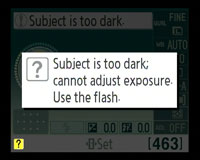 | |
Similar its predecessor, the D3000 has sensibly retained the context-sensitive help organization which displays handy hints on the current setting or menu whenever y'all press the Question marker button. Sometimes yous'll see the question marking blinking in the corner of the screen, in which case the D3000 believes something's wrong and wants to brand a proffer, such as to use the flash. If only all cameras were this friendly.
The D3000 however goes one step further than its predecessor with its headlining Guide mode – a brand new feature which proudly has its own position on the main style punch. Through a friendly sorcerer, the Guide style substantially asks what kind of photograph you want to take and and so chooses the optimal settings to achieve the desired effect.
It starts with three main options: Shoot, View / Delete and Setup. Choosing Shoot presents three options: Easy Functioning, Avant-garde Performance and Timers & Remote Control. In the Piece of cake Operation department the D3000 lets you lot choose from what are effectively nine scene presets: Car, No Flash, Distant Subjects, Shut-ups, Sleeping Faces, Moving Subjects, Landscapes, Portraits and Dark Portraits. Some but recognise that in the specified situation the wink or AF illuminator would either be unwelcome or redundant, so forbid it from operating.
Things get more interesting in the Advanced Operation section, where you lot're given the option of Soften Backgrounds, Freeze motion (people) and Freeze move (vehicles). Equally yous might expect, these get friendly interfaces for using Aperture and Shutter Priority. Soften Backgrounds automatically switches the D3000 into Aperture Priority mode, and lets you choose an f-number, with the camera explaining that lower f-numbers blur the background.
Similarly the Freeze motion options switch the D3000 into Shutter Priority mode and let you to adjust the shutter speed, with the D3000 advising fast shutter speeds should be chosen to 'freeze' movement. The people and vehicle options advise using shutter speeds of at to the lowest degree one/200 or ane/g respectively.
If you effort and choose too fast a shutter speed for the bachelor low-cal, the D3000 warns the subject will go too dark. Interestingly rather and so automatically bumping up the sensitivity though, the D3000 sticks with a fixed value and 'lets' y'all change it manually later, which seems less helpful than it could have been. In one case you've chosen the desired shutter or aperture value, the D3000 and then asks if you'd similar more than settings, or start shooting. The more settings option lets you arrange the flash mode, moving-picture show command, release mode, exposure bounty, AF area or fashion, and the wink bounty, each accompanied by thumbnail images showing how each might be used.
The Timers and remote control section but presents the release mode options in a redesigned card, allowing you to choose between single, continuous, cocky-timer, or remote control with the optional wireless remote. Likewise, returning to the beginning page, the View / delete and Set upward options present simplified versions of the normal menu sections for each.
In use, the Guide department certainly presents a beginner-friendly interface to operating the D3000, and nosotros can imagine many first-timers leaving it on this mode most of the fourth dimension. Just it'due south certainly not 100% foolproof across all the options. As mentioned above, the Advanced modes can let you punch-in an aperture or shutter speed which volition result in under or over-exposure, and while the D3000 will warn yous of this, the Guide mode won't automatically arrange the sensitivity to solve at least some of these situations. For example if you choose to Freeze movement in the Advanced mode with too fast a shutter speed for the available light, the D3000 simply says the prototype will be besides dark, rather than increasing the ISO to compensate, or at least suggesting it.
As you can see from the screengrabs above, the Advanced manner also expects you lot to understand shutter speeds presented every bit fractions and the discontinuity expressed as f-numbers. These are easy concepts for those familiar with the technical side of photography, but complete beginners may take constitute it easier if fractions and f-numbers were hidden altogether and instead simple sliders shown with graphics indicating blurriness at one end and sharpness at the other.
In this respect, Sony and Catechism's beginner interfaces are arguably more intuitive (if not quite as hand-belongings). To be fair, these criticisms only apply to the D3000'southward 'Avant-garde Operation' section in Guide mode, and complete beginners should caput for the Easy Functioning section instead, where things really are genuinely easy. We're existence critical here considering on the whole, Nikon leads the pack in overall friendliness on its DSLRs, and the Guide manner further enhances this experience. Every bit such the D3000 remains the easiest overall DSLR we've tested for beginners, only we feel the Avant-garde Operation mode could have been a little more helpful.
Nikon D3000 menus
At first glance, the D3000's menus look similar to the D60, but there's been some rearrangements. The Custom settings menu has now gone, with key options (similar configuring the Part and AE / AF lock buttons) at present relocated to the main Setup bill of fare. New to the D3000 over the D60 is a Recent Settings card which keeps a record of your final seven changes for easy reference.
The Retouch menu is however nowadays, offering in-camera adjustments which include D-Lighting, cherry-eye correction, crop, various filter effects, colour balance, image overlay, RAW processing, an outlining consequence and a Miniature selection which throws everything other than a narrow strip out of focus for a tilt and shift upshot.
The D3000 has withal inherited the D60's Stop Motility selection which can assemble a sequence of upwards to 100 still images into a picture clip exported in the AVI format. Yous can switch the output resolution between 640×480, 320×240 and 160×120 pixels, and the frame rate from 3, 6, 10 or 15fps. With the maximum 100 frames and smoothest 15fps frame charge per unit, a sequence will final half dozen seconds and typically measure around 15MB at VGA resolution.
Information technology'due south a shame there's no smoothen 30fps pick nor a built-in Intervalometer which will automatically take the photos for you, merely information technology'southward nevertheless a fun addition and the closest the D3000 (or indeed its budget rivals) come to offering a movie mode.
During playback you can cycle through a number of pages which have been updated in line with Nikon'southward higher-end bodies. As such with all Display options ticked, you tin can view iii pages of shooting information, a thumbnail with either brightness or RGB histograms, or blinking highlights. This is a big comeback over the D60 which only offered a brightness histogram, and forced you to enter the colour residuum section of the retouch bill of fare to reveal RGB histograms. Thanks for calculation these to the D3000 Nikon.
| Support this site by cost checking below  |
Nikon D3000 battery and connectivity
The Nikon D3000 employs a slightly updated version of the battery in its predecessor. The new EN-EL9a is rated at 1080mAh (80 more than the EN-EL9), with Nikon claiming it's now practiced for 550 shots under CIPA conditions compared to the 500 of the D60.
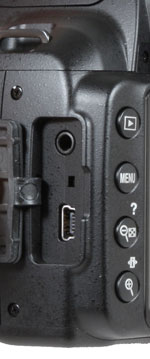 |
Battery life is indicated by a three segment graphic on the master screen, although unlike college end models in the range, there'south no support for Nikon's Fuel Gauge arrangement which provides an accurate feedback of the bombardment life and condition (albeit via a menu pick).
Similar its predecessor, at that place's no official battery grip. Sony's Blastoff A230 doesn't have a bombardment grip either, once again leaving the Catechism EOS 1000D / XS as the only 1 in the budget triplet with the capability.
The Nikon D3000 has an SD memory bill of fare slot behind a door on the right side and like most DSLRs no card is supplied as standard. If more than 1000 pictures are remaining, the number is rounded and abbreviated to read, say, one.1K for 1100 photos.
Backside a flap on the left side are a USB port, TV output and a recessed reset button. A USB cable is supplied, merely in a money-saving exercise, the Television cable is an optional accessory in some regions. So of the three budget rivals, but Sony's Blastoff A230 offers an HDMI output, although it does and then at the cost of a standard Tv output.
Now let's observe out more virtually the D3000's features including its lens, focusing, sensor and continuous shooting capabilities.
Pages: 1 2 3 four 5 vi 7 8 9 10 11
Source: https://www.cameralabs.com/nikon_d3000/2/
Posted by: baxteratudeas46.blogspot.com


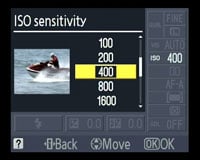
0 Response to "Is There A Way To Use The Screen On The Camera To See The Picture On A Nikon D3000"
Post a Comment